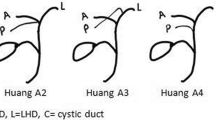Abstract
Background and objectives
Living donor liver transplantations (LDLT) donor candidates are being assessed with MRCP (magnetic resonance cholangiopancreatography) to identify their suitability for standard surgical techniques. Variations of the bile duct anatomy play an important role in donor selection and in the selection of the resection technique. If bile duct anatomy is misrecognized, complications may occur. Anatomic variations are classified according to the origin of the right posterior hepatic duct (RPHD). According to the so called Huang classification, type A1 is the most, and type A5 is the least frequent variation. These frequencies were initially validated on Chinese population. Later studies revealed significant variability in frequency for the so called trifurcation, the variation in which a common junction of RHPD, right anterior hepatic duct (RAHD) and left hepatic duct (LHD) (A2) exists. In this study we aimed to determine the bile duct anatomy variations for the Anatolian Caucasians.
Methods
One hundred and thirty-four healthy subjects were investigated under 1.5 T MRI, with breath-hold (expiration) heavily T2-weighted turbo spin echo (TSE) static fluid imaging (TR/TE = 8,000/800). The sequence has permitted three to five oblique coronal thick sections (40 mm) around a common axis. Sequences were repeated until anatomically interpretable images were obtained. Diagnostic images could not be obtained in 22 subjects. Radiologists who were fully experienced in LDLT assessment investigated these images, and classified them for the surgical variations of the bile duct anatomy.
Results
One hundred and twelve subjects (58 men, 54 women) who were classified were between 14 and 81 years of age (mean: 39.3; SD 14.1). According to Huang classification, 61 of them (55%) were classified as type A1 (normal right and left hepatic duct junction), 16 (14%) as type A2 (common junction of RAHD, RHPD and LHD), 24 (21%) as type A3 (aberrant drainage of RPHD to left main duct), and 11 (10%) as type A4 (aberrant drainage of RPHD to main hepatic duct). When subjects, in whom the distance (d) between RPHD insertion and the right and left hepatic duct junction is less than 1 cm, are classified as type A2, the type A1 prevalence decreases to 28%. For the entire population that distance was between 3 and 25 mm (mean: 9.8, SD: 4.8). Accordingly, the frequency of type A1 anatomy was 8–29% lower than the respective frequency in Chinese population.
Conclusion
From the surgical perspective, close proximity (d < 1 cm) of RPHD to right and left hepatic duct junction is considered as type A2 variation. According to that concept, type A1, usually accepted as the dominant anatomic variation, is encountered only in 28% of the Anatolian Caucasians. We have proposed a modified surgical classification in which Huang type 2 was subdivided into types K2a (close proximity) and K2b (trifurcating). The predominance of K2 types in the population of the study may necessitate the use of bench ductoplasty in many liver grafts.






Similar content being viewed by others
References
Champetier J (1994) Les voies biliaires. In: Chevrel JP (ed) Anatomie clinique, Le tronc. Springer, Paris, p 416
Cheng YF, Huang TL, Chen CL, Chen YS, Lee TY (1997) Variations of the intrahepatic bile ducts: application in living related liver transplantation and splitting liver transplantation. Clin Transplant 11:337–340
Dusunceli E, Erden A, Erden I (2004) Anatomic variations of the bile ducts: MRCP findings. Tani Girisim Radyol 10:296–303
Harma A, Karakas HM (2007) Determination of sex from the femur in Anatolian Caucasians: a digital radiological study. J Forensic Leg Med 14:190–194
Huang TL, Cheng YF, Chen CL, Lee TY (1996) Variants of the bile ducts: clinical application in the potential donor of living-related hepatic transplantation. Transplant Proc 28:1669–1670
Kapoor V, Peterson MS, Baron RL, Patel S, Eghtesad B et al (2002) Intrahepatic biliary anatomy of living adult liver donors: correlation of mangafodipir trisodium-enhanced MR cholangiography and intraoperative cholangiography. Am J Roentgenol 179:1281–1286
Kim RD, Sakamoto S, Haider MA, Molinari M, Gallinger S et al (2005) Role of magnetic resonance cholangiography in assessing biliary anatomy in right lobe living donors. Transplantation 79:1417–1421
Kitami M, Takase K, Murakami G, Ko S, Tsuboi M (2006) Types and frequencies of biliary tract variations associated with a major portal venous anomaly: analysis with multi-detector row CT cholangiography. Radiology 238:156–166
Limanond P, Raman SS, Ghobrial RM, Busuttil RW, Lu DSK (2004) The utility of MRCP in preoperative mapping of biliary anatomy in adult-to adult living related liver transplant donors. J Magn Reson Imaging 19:209–215
Lorabina M, Nottle P. (2005) Extrahepatic biliary anatomy at laparascopic cholecystectomy: is aberrant anatomy important? ANZ J Surg 75:392–395
Ohkubo M, Nagino M, Kamiya J, Yuasa N, Oda K et al (2004) Surgical anatomy of the bile ducts at the hepatic hilum as applied to living donor liver transplantation. Ann Surg 239:82–86
Sahani D, D’souza R, Kadavigere R, Hertl M, McGovan J et al (2004) Evaluation of living liver transplant donors: method for precise anatomic definition by using a dedicated contrast-enhanced MR imaging protocol. Radiographics 24:957–967
Wietzke-Braun P, Braun F, Müller D, Lorf T, Ringe B et al (2006) Adult-to-adult right lobe living donor liver transplantation: Comparison of endoscopic retrograde cholangiography with standard T2-weighted magnetic resonance cholangiography for evaluation of donor biliary anatomy. World J Gastroenterol. 12:5820–5825
Acknowledgments
This study was supported by Inonu University Scientific Research Projects Unit (IU-BAP) under the grant “2005/GUZ-1/GUDUMLU”. This study on LDLT was approved by Turgut Ozal Medical Center Organ Transplantation Council. Informed consent was obtained from all donor candidates and healthy subjects according to our institutional guidelines.
Author information
Authors and Affiliations
Corresponding author
Rights and permissions
About this article
Cite this article
Karakas, H.M., Celik, T. & Alicioglu, B. Bile duct anatomy of the Anatolian Caucasian population: Huang classification revisited. Surg Radiol Anat 30, 539–545 (2008). https://doi.org/10.1007/s00276-008-0365-y
Received:
Accepted:
Published:
Issue Date:
DOI: https://doi.org/10.1007/s00276-008-0365-y




